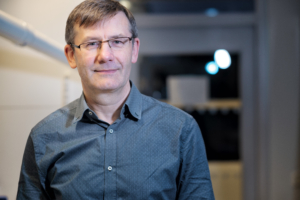Three questions to
Prof. Prof. Tautgirdas Ruzgas (Biofilms Research Centre for Biointerfaces, Malmö University) about the Intereg project CINDIS – Consortium for Intelligent Diagnostics of Skin cancer
• What´s the novelty with this project?
Skin cancers are today detected by visual observation, AI supported image analysis of suspected lesions, measurements of changes in tissues impedance, etc., but still some skin cancers are not detected. In our project we are developing a methodology to collect metabolic biomarkers from the surface of suspected skin lesions. This approach is rather unique and currently we are assessing it on persons with suspected skin melanoma cancers. The number of available biomarkers is very small and thus the process of sampling and analysis must be understood and optimized on the molecular and nano level.
• Future implications?
We hope that this methodological approach will provide powerful and affordable tools for broad and non-invasive detection of skin cancers as well as for monitoring of skin inflammatory diseases.
• What´s next?
If proof-of-concept will be successful, the method should be validated on a larger number of cancer patients. We already now know that clinical viability and clinical compatibility will not be possible to reach without the most recent nanotechnology advances being integrated into the epidermal sensing. We would be happy to expand collaborations with universities and industries which could help us to improve molecular sampling from skin and, in the end, to translate the methodology into the cancer diagnostics compatible with clinical routines.
For more information please contact Tautgirdas Ruzgas
tautgirdas.ruzgas@mau.se

Tautgirdas Ruzgas
Foto Håkan Röjder
Research highlights from NanoMed North members
If you would like to share a publication within the nanomedicine area please contact magdalena.almen@medeon.se
-
Amoxicillin-loaded nanofibers for topical skin delivery applications
Unique physiochemical and biological properties of nanofibers along with the choice of a wide variety of materials for both fabrication and tunable release patterns make nanofibers an ideal option for drug delivery. This work introduces antibiotic-loaded nanofiber substrates with potential for topical skin delivery applications, reduced consumption of antibiotics and increased storage time. Read abstract here.
-
Optimization of nanostraw transfection
Nanostraw substrates have great potential for achieving minimally invasive cell transfection. However, it can be challenging to achieve the desired effect when working with small cell populations due to uncovered nanostraws. This work show that this issue can be addressed by covering the nanostraw substrate with an insulating layer containing pores of similar size to cells. Find out more here.

-
Reversible self-assembled monolayers
Cells adhering onto surfaces sense and respond to chemical and physical surface features. Reversible self-assembled monolayers (rSAMs), featuring mobile bioactive ligands offer unique capabilities to influence and control cell adhesion behavior, suggesting a broad use in biomaterial design, tissue engineering, and regenerative medicine. Read more about this work here.





